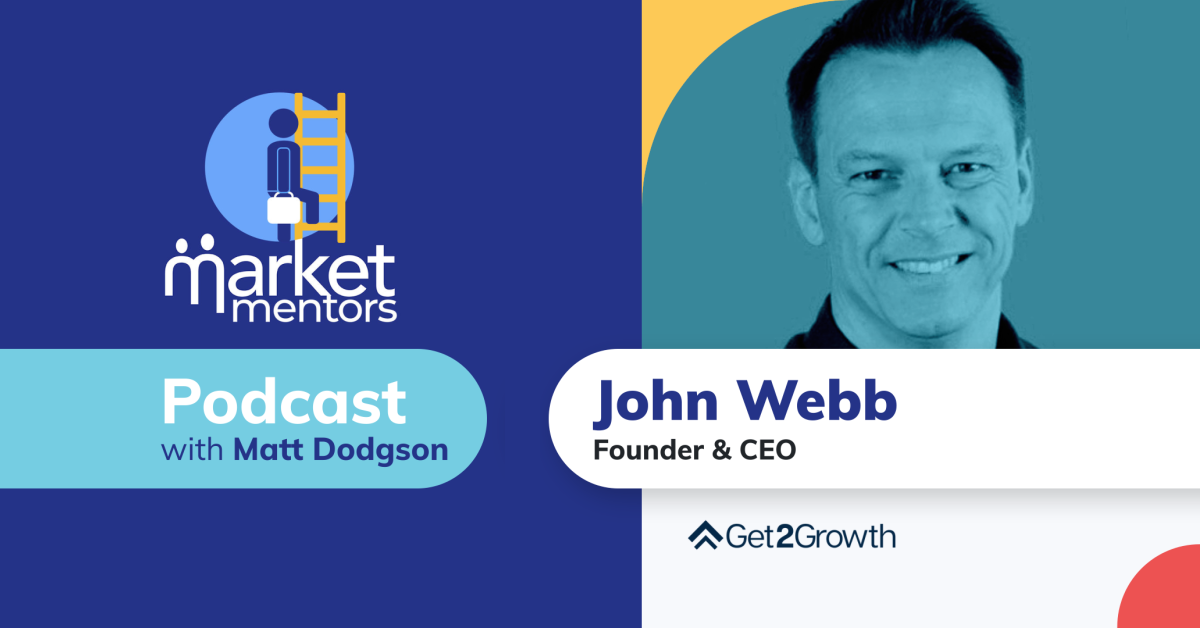
In the digital age, data is king. And for B2B marketers, this treasure trove of information holds the key to unlocking new opportunities and driving demand. But how exactly can data be used to achieve these goals?
In this podcast, I talk to John Webb, Founder and CEO of Get2Growth, about the power of data in the B2B market and provide actionable insights on how to leverage it effectively.
Who they are: John Webb is the founder and CEO of Get2Growth.
A bit of background:, John works with B2B and media businesses to help them unlock audiences through data and develop new commercial models and revenue streams.
Where you can find John:
Connect with John on LinkedIn here
B2B companies often possess a treasure trove of data, but they fail to realise its full value. So understanding the significance of their data is the first step towards unlocking its potential.
But what are the opportunities?
John highlights two key opportunities:
John goes on to explain the benefit:
‘Firstly, there’s the value of what you can do with the data. So how can you unlock the data and the different models that you can build on top of it? But also as an asset, as it significantly increases the valuation of a company. If a company has rich data assets and is scaling, then that is hugely valuable for future investors.’
First and foremost, many companies face a fundamental challenge in efficiently capturing data. Often, they adopt simplistic approaches, relying heavily on a limited set of techniques. For instance, newsletters serve as the primary means of gathering user data, but this narrow focus blinds them to numerous untapped opportunities. So diversifying data capture methods can lead to richer insights and more comprehensive datasets.
Secondly, there exists a lack of comprehension and appreciation for the legislative aspects of data management, particularly regarding data privacy and compliance. While GDPR has been around for five years, companies may grow complacent, assuming they have mastered its intricacies. However, the global data landscape is ever-evolving, with new legislation emerging in various regions. So maintaining a deep understanding of data regulations is crucial to ensuring compliance and responsible data usage.
Thirdly, the way companies leverage data through nurturing techniques has significant implications. John goes on to explain:
‘The majority of companies that I come across are pretty poor when it comes to their ability to nurture users, prospects, and customers, however you want to describe them, especially when looking at nurture from a first-data point of view but also from a multi-channel point of view.’
Companies must consider what value they can provide to customers to incentivise them to share their data.
John suggests three key areas to focus on:
John goes on to explain:
‘So the first part of it is that to turn an unknown audience into a known audience, you’ve got to capture that data in the first place. So give them that value equation to do that. But like I said before, the key thing that I think a lot of people don’t focus on and don’t invest in is the nurturing side of things. ’
When it comes to nurturing strategies, the key lies in adopting a multi-channel approach. By integrating the site experience with email, social media, and messenger platforms, you can create a diverse and engaging nurture programme. The abundance of channels and tools available allows for repeated touchpoints with your audience, fostering deeper connections.
With data collection being crucial, progressive profiling emerges as a powerful technique. It involves gathering initial information about individuals, companies, or purchase processes, and gradually building on that data over the course of the nurture programme. This gradual approach ensures a steady flow of valuable insights.
Through this multi-channel, data-driven nurturing approach, you can craft personalised journeys for each individual or company, enhancing the effectiveness of your nurturing strategy. So embrace the complexity and variation in your content to maximise the impact of your nurturing programme.
There are, of course, many ways to build a demand generation engine, depending on your product, service, or solution and your go-to-market strategy.
But John suggests thinking about the following aspects:
Spiceworks is an online community where users can collaborate, seek advice from one another, and also engage in a marketplace to purchase IT services and products. According to estimates, 3,000 technology vendors and more than six million IT professionals use the network. So they had a huge amount of data but weren’t utilising it enough to help drive revenue growth.
Firstly, the key for John and the Spiceworks team was understanding and appreciating the different data sets they had access to, which included:
Additionally, the business collected declared data through surveys and annual polls, providing valuable insights.
So appreciating and combining all these parts of the data was essential. By doing this through a customer data platform, they could gain a more intricate view of individuals, companies, and even buying groups. Creating refined audience groups or segments allowed them to build personalised customer journeys. They focused on understanding user behaviour, content consumption, and engagement, leading to eventual purchases.
As a publisher and platform, Spiceworks monetised their insights by assisting B2B vendors in interacting with audiences at critical points through various channels like advertising, email, and social media. The result was that they generated intent and leads to serve their vendors effectively. Their data-driven approach allowed them to build a robust system and model centred around rich profiles, automation, and constant demand optimisation.
In essence, the key was mastering the underlying principles of data integration, segment creation, and automation, which empowered them to drive demand and drive business success across different processes and partnerships.
Subscribe to our fortnightly newsletter to hear about our latest podcasts, blogs, career advice & jobs.